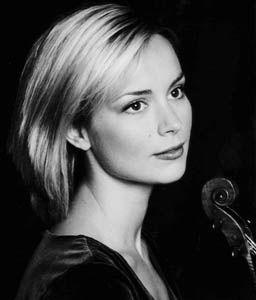![[Metroactive Music]](/gifs/music468.gif)
[ Music Index | Santa Cruz | Metroactive Home | Archives ]
What's Good for the Goose
The Santa Cruz Symphony's upcoming program takes on 'Mother Goose' but also says something about the meaning of music
By Scott MacClelland
Those who say music is art are wrong. Music is language, as capable of poetry as of slang, as lofty and as low, depending on how, why and where it is practiced. In fact, during the last quarter of the 18th century, music was Europe's universal language, when musicians and music lovers raised to speak Walloon, Portuguese, Greek, English, Latvian and Czech all "spoke" and understood the same language of music.
So do we still--whether we know it or not--be it classical, jazz, rock or hip-hop. Nevertheless, ancient arguments are still debated: What's more important, the words or the music? Is instrumental music "purer" than vocal music? Is "absolute" music better than "program" music? Etc., etc. On that last point, British composer Edward Elgar said, "I do not say that program music should not be written, but I do maintain that it is a lower form of art than absolute music." German contemporary Richard Strauss rejoined, "There is no such thing as abstract music; there is good music and bad music. If it is good, it means something; and then it is program music." Absolute? Abstract? When asked to explain the meaning of Beethoven's Fifth Symphony, the conductor Arturo Toscanini, demurring to the composer's own words, declared, "Allegro con brio."
Behind the debates, beneath musical phonology and syntax, lies the mystery of musical semantics. What does music mean? Happily, that exquisitely unanswerable question has sustained my long career as a music history teacher and critic.
At their concert this Saturday, the Santa Cruz Symphony seems to take Strauss' side. Each of the three works on the program starts with an extramusical premeditation. Maurice Ravel's Ma mere l'oye visualizes characters from Mother Goose. Max Bruch's pictorial Scottish Fantasy draws on various Scottish folk melodies. Peter Ilyich Tchaikovsky's Symphony no. 2 takes its cues from the folk music of Ukraine.
Joining John Larry Granger in the spotlight is Caroline Campbell, the violin medalist of the 2002 Klein International String Competition and, in the same year, first prize-winner in the Carmel Music Society's annual competition. Now a resident of Pasadena, Campbell has appeared as concerto soloist with the Los Angeles Philharmonic (including the Tchaikovsky concerto at age 16), Boston Symphony, Cleveland Orchestra and Indianapolis Symphony. She has performed frequently in New York and established herself in Europe. She studied with Donald Weilerstein and attended master classes with Dorothy Delay, Robert Mann, Cho-Liang Lin, and Ruggiero Ricci. Among her competition winnings are the Tibor Varga International Violin Competition in Switzerland (and its prestigious Paganini Prize), grand prize at the Corpus Christi International Young Artists Competition (and its best solo Bach prize), silver medal at the Stulberg International String Competition and first prize in the Sorantin International Young Artist Competition. She performed at the White House during the Clinton Administration. In addition to her concerto repertoire, she is active as a recitalist and chamber music player.
In Santa Cruz, Campbell will play the five-movement Scottish Fantasy, a work completed in 1880 by Bruch for the celebrated virtuoso Pablo de Sarasate and premiered in 1881 by the famed Joseph Joachim. The work, a signature piece of Jascha Heifetz, uses Scots tunes "Thro the Wood Laddie," "Dusty Miller," "I'm a doun for lack o Johnnie" and the war march of Robert the Bruce, "Scots wha hae." It also paints the rugged landscape of Scotland in much the same vein as Mendelssohn's "Scottish" Symphony and Hebrides Overture.
Ravel's Mother Goose, composed originally as a set of piano pieces for the children of friends, took its better-known orchestral shape as a ballet first given in 1912 in Paris. The orchestration is as magical as the fairy tales it seeks to portray, not least the clarinet-contrabassoon dialogue of Beauty and the Beast. Perhaps its most enchanting movement is the gamelan-inspired "Laideronnette, Empress of the Pagodas."
One wonders if Tchaikovsky's original title for his second symphony, "Little Russian," will be altered to "Ukrania," which would make it more PC to the residents of that now-independent nation. In any case, the composer starts the work on solo horn with "Down by the Volga," which then becomes the primary theme of the first movement. A dance-song appears in the third movement trio. The round dance, "The Crane," becomes the theme for the variations of the finale. For the second movement, "Andantino marziale," Tchaikovsky recycled an episode from his opera Undine, later destroyed.
[ Santa Cruz | Metroactive Central | Archives ]
Copyright © Metro Publishing Inc. Maintained by Boulevards New Media.
For more information about Santa Cruz, visit santacruz.com.
![]()

Does It Have Anything to Do With That 'Hey, Mccloud, Get Off of My Ewe' Joke?: Violinist Caroline Campbell, winner of the Klein International String Competition and the Carmel Music Society's annual competition, joins the Santa Cruz Symphony this Saturday for Bruch's five-movement 'Scottish Fantasy.'
From the November 3-10, 2004 issue of Metro Santa Cruz.